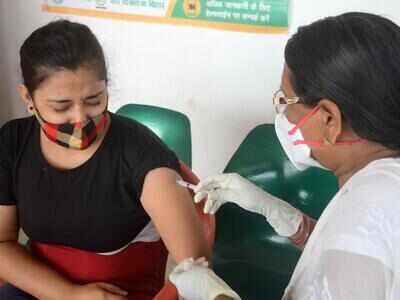- News
- City News
- ranchi News
- Jharkhand: Lockdown, vaccination drive help bring down active caseload by over 7,140
Jharkhand: Lockdown, vaccination drive help bring down active caseload by over 7,140

As per the state IDSP’s cell data, Jharkhand had reported the maximum number of active cases - 59,673 - on May 4. (Representative photo)
RANCHI: After recording a steep surge in Covid-19 cases in the past few months, the number of cases has gone down in Jharkhand with the active caseload going down by 7,140 last month.
As per the state health department data, Jharkhand had witnessed 8,054 active cases on June 1 which reduced to 914 on June 30. The fresh infection graph too has come down as state had reported 609 infections on June 1 and 85 on June 30.
Experts believe that the strict lockdown and the vaccination drive helped Jharkhand overcome the second wave.
Talking to TOI on the issue, professor of critical care and the in-charge at the trauma centre at the state-run Rajendra Institute of Medical Sciences (Rims), Dr Pradeep Bhattacharya, said, “The infection rate as well as the mortality rate came down last month and the lockdown is responsible. Also, people’s overall awareness regarding Covid-appropriate behaviour contributed to this well.”
He added, “The patient inflow has also reduced to a minimum and we are keeping the Covid wards on standby. There was a time when people had to wait for hours to get a bed in ICU. Now we hardly have any Covid patient in ICU.”
The virus was at its peak in Jharkhand between April 15 and May 15 as new variants were confirmed through genome sequencing of Covid-19 samples from the state. As per the state IDSP’s cell data, Jharkhand had reported the maximum number of active cases - 59,673 - on May 4.
A few experts also believe that the decline in the transmission rate is a result of the high infection rate experienced during the second wave. “It is in the nature of any virus to mutate and it becomes more infectious after mutation which is why we saw an increase in the death rate during the peak of second wave. Even now there is an undercurrent transmission and people who haven’t been infected can be at risk. But the decline is a result of the vaccination drive as well as the lockdown s and if we are to experience a third wave this experience will be very helpful for the community,” public health expert and professor of community medicine at Rims, Dr Dewesh Kumar said.
As per the state health department data, Jharkhand had witnessed 8,054 active cases on June 1 which reduced to 914 on June 30. The fresh infection graph too has come down as state had reported 609 infections on June 1 and 85 on June 30.
Experts believe that the strict lockdown and the vaccination drive helped Jharkhand overcome the second wave.
Talking to TOI on the issue, professor of critical care and the in-charge at the trauma centre at the state-run Rajendra Institute of Medical Sciences (Rims), Dr Pradeep Bhattacharya, said, “The infection rate as well as the mortality rate came down last month and the lockdown is responsible. Also, people’s overall awareness regarding Covid-appropriate behaviour contributed to this well.”
He added, “The patient inflow has also reduced to a minimum and we are keeping the Covid wards on standby. There was a time when people had to wait for hours to get a bed in ICU. Now we hardly have any Covid patient in ICU.”
The virus was at its peak in Jharkhand between April 15 and May 15 as new variants were confirmed through genome sequencing of Covid-19 samples from the state. As per the state IDSP’s cell data, Jharkhand had reported the maximum number of active cases - 59,673 - on May 4.
A few experts also believe that the decline in the transmission rate is a result of the high infection rate experienced during the second wave. “It is in the nature of any virus to mutate and it becomes more infectious after mutation which is why we saw an increase in the death rate during the peak of second wave. Even now there is an undercurrent transmission and people who haven’t been infected can be at risk. But the decline is a result of the vaccination drive as well as the lockdown s and if we are to experience a third wave this experience will be very helpful for the community,” public health expert and professor of community medicine at Rims, Dr Dewesh Kumar said.
FacebookTwitterLinkedinEMail
Start a Conversation
end of article
Quick Links
Delhi Air PollutionDelhi TemperatureChennai WeatherBangalore TemperatureCovid vaccination centres in DelhiCoronavirus in DelhiRTPCR test in GurgaonHyderabad RainPollution level in BangaloreDelhi SmogDelhi TemperatureNoida AQIGurgaon AQI todayFire in MumbaiMumbai RainsCovid 19 RT PCR Test in NoidaDelhi AQI todaySrinagar encounter
